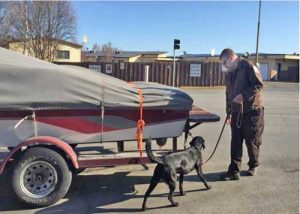
Operation Barnacle Buster was an eight-day inspection blitz executed at the Alaskan Port of Alcan on the border of the United States and Canada. The operation was conceived because of the continual threat of invasive species entering the State of Alaska. The Service also used the operation as an opportunity to enforce Federal, State, foreign, and international wildlife laws and regulations. In addition, the operation provided outreach to the general public and to the U.S. Customs and Border Protection (CBP) concerning those laws.
In the mid-2000s, CBP in Alaska established the Alaska Pest Risk Assessment Committee (AKPRAC), which is comprised of various Federal and State agencies. AKPRAC identified recreational boats as one of the most serious hazards to the State since they can be a host for zebra and Quagga mussels as well as other invasive species.
Anchorage Service wildlife inspectors, an evidence custodian, and the wildlife detection canine “Dock” inspected over 140 vehicles daily to determine whether they possessed any wildlife including live wildlife, wildlife parts, or wildlife products.
The Wildlife Inspectors are certified in watercraft inspection and decontamination and ensured that those working this operation understood basic boat inspection procedures for zebra and Quagga mussels. They also were present throughout the entire operation to assist in determining the risks posed by each watercraft that was inspected.
The Service inspected all inbound vehicles and some outbound vehicles. In total, 1,145 vehicles were inspected and 37 of those vehicles were towing watercraft. Although no invasive species were detected, wildlife violations were discovered in 24% of the vehicles that carried wildlife or wildlife products. These violations included those against the Endangered Species Act, the Migratory Bird Treaty Act, the Lacey Act, and the Convention on International Trade in Endangered Species of Wild Fauna and Flora (CITES).
This operation was purposely executed during the peak of watercraft imports at the border. The majority of boats that entered the State had originated in or were last used in areas known to have zebra and Quagga mussel populations. It is imperative that the Service continues its due diligence in countering the threat of invasive and injurious species. This operation highlights the need for future operations as well as the establishment of a more long-term solution to ensuring boat inspections at the border. Most western lower 48 States have inspection stations and systems in place to ensure boats are not moved from one infested lake to another. In the past 30 years, zebra and Quagga mussels have spread from Lake Michigan to two-thirds of the continental U.S. states. Once a waterway is compromised, there is little hope of eradicating them.
Source: USFWS



